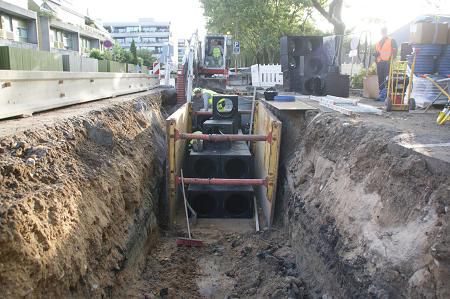Frederiksberg becomes the first Danish municipality to protect itself against flooding after cloudbursts with a new, sustainable system of underground rainwater basins. Betty Nansens Allé will be the first road with the new system
In many places, the heavy and sudden amounts of rainwater can neither be absorbed naturally in the ground nor through existing sewer systems. The result is flooding of streets, alleys, yards, gardens, buildings and basements. As well as the destruction of vital infrastructure.
Frederiksberg Municipality does not go unnoticed. Therefore, the municipality is the first in Denmark to invest in a new system of modular underground rainwater basins to store and manage rainwater after cloudbursts.
If you’re thinking Lego bricks, you’re well on your way to understanding how the new system works.
In its assembled form, the building blocks – in the form of watertight containers – form a square piping system that is assembled as modules into one or more interconnected and larger, watertight pools.
The basins are connected in height, width and length depending on their individual dimensions and the specific conditions at the immersion site. They are typically placed together under existing roads, with only 35-40 centimeters between the top modules and the road’s asphalt surface. The modules are constructed from a composite material that can withstand the highest classifications of urban traffic congestion.
The basins are designed to collect and store rainwater either through the system’s own grates, existing road gullies or in a combination of the two options in municipal roads.
Recyclable rainwater
The dimensioning and location of the system depends on the municipality’s studies and assessments, just as it is the municipality’s decision how the stored cloudburst water is re-discharged from the closed basin system.
For the future solution under Betty Nansens Allé, Frederiksberg Municipality has chosen to redirect the water through the existing sewer system when the load on the sewer system after the cloudbursts allows it again.
Alternatively, with a few adjustments, the system can either be designed to allow rainwater to percolate in regulated quantities to the underlying soil layer or retain the rainwater, which can then be reused. The finished system can be supplied with substrates for cleaning the collected rainwater and growing media for watering municipal tree and plant beds and green areas, for example.
The construction project on Betty Nansens Allé started in week 38, and the system is expected to be ready to collect the first rainwater from the beginning of April next year.
Environmentally conscious and Danish produced
The Danish company Urban Water Retention (UWR) is behind the modular system for storing and managing rainwater in cities and urban areas.
– We have been preparing for this first project with the modular solution for more than four years, so we are naturally looking forward to completing the installation. We expect to complete the work with the least possible inconvenience to residents and road users, while securing the area and Frederiksberg this environmentally friendly and sustainable solution, says UWR partner Lars Knudsen.
Founded by experts with more than 35 years of experience in production, development, construction and sewerage, the company is already a supplier of underground basins to Frederiksberg Municipality. The new UWR system is therefore a supplement and optimization of the existing types of cloudburst solutions in the municipality.
The UWR system represents a consistently responsible climate and CO2 solution with a focus on the material selection and production, which is fully traceable, documented and verified by a recognized Danish research institute, the construction phase and time, the logistics and the finished product and its guaranteed lifetime.
-dc
